Numerical Modeling of Kinetic Features and Stability Analysis of Jinpingzi Landslide
Abstract
1. Introduction
2. Geological Conditions of the Jinpingzi Landslide
2.1. Geological Conditions
2.2. Characteristics of the Jinpingzi Landslide
3. Numerical Model of Particle Flow Code 3D (PFC 3D)
3.1. Micro-Parameters of PFC3D
3.2. Strength Reduction Theory (SRT)
3.3. Generation of the Jinpingzi Landslide Model
3.4. Stability Analysis Based on Displacement Vector Angle (DVA)
4. Simulation Results
4.1. Kinetic Features of the Jinpingzi Landslide
4.2. Stability Analysis of Jinpingzi Landslide
5. Discussion
6. Conclusions
Author Contributions
Funding
Data Availability Statement
Conflicts of Interest
References
- Wan, S.; Lei, T.C.; Chou, T.Y. A novel data mining technique of analysis and classification for landslide problems. Nat. Hazards 2010, 52, 211–230. [Google Scholar] [CrossRef]
- Vinueza, A.U.; Handwerger, A.L.; Bakker, M.; Bogaard, T. A new method to detect changes in displacement rates of slow-moving landslides using InSAR time series. Landslides 2022, 19, 2233–2247. [Google Scholar] [CrossRef]
- Nefeslioglu, H.A.; Gokceoglu, C.; Sonmez, H.; Gorum, T. Medium-scale hazard mapping for shallow landslide initiation: The Buyukkoy catchment area (Cayeli, Rize, Turkey). Landslides 2011, 8, 459–483. [Google Scholar] [CrossRef]
- Luo, G.; Hu, X.; Gu, C.; Wang, Y. Numerical simulations of kinetic formation mechanism of Tangjiashan landslide. J. Rock Mech. Geotech. Eng. 2012, 4, 149–159. [Google Scholar] [CrossRef]
- Jeong, S.W. The viscosity of fine-grained sediments: A comparison of low- to medium-activity and high-activity clays. Eng. Geol. 2013, 154, 1–5. [Google Scholar] [CrossRef]
- Fan, X.; Qiang, X.; Scaringi, G.; Dai, L.; Havenith, H.B. Failure mechanism and kinematics of the deadly June 24th 2017 Xinmo landslide, Maoxian, Sichuan, China. Landslides 2017, 14, 2129–2146. [Google Scholar] [CrossRef]
- Intrieri, E.; Raspini, F.; Fumagalli, A.; Lu, P.; Conte, S.D.; Farina, P.; Allievi, J.; Ferretti, A.; Casagli, N. The Maoxian landslide as seen from space: Detecting precursors of failure with sentinel-1 data. Landslides 2018, 15, 123–133. [Google Scholar] [CrossRef]
- Kundu, J.; Sarkar, K.; Ghaderpour, E.; Scarascia Mugnozza, G.; Mazzanti, P. A GIS-Based Kinematic Analysis for Jointed Rock Slope Stability: An Application to Himalayan Slopes. Land 2023, 12, 402. [Google Scholar] [CrossRef]
- Huang, B.; Yin, Y.; Wang, S.; Chen, X.; Liu, G.; Jiang, Z.; Liu, J. A physical similarity model of an impulsive wave generated by gongjiafang landslide in Three Gorges Reservoir, China. Landslides 2014, 11, 513–525. [Google Scholar] [CrossRef]
- He, C.; Hu, X.; Tannant, D.D.; Tan, F.L.; Zhang, Y.M.; Zhang, H. Response of a landslide to reservoir impoundment in model tests. Eng. Geol. 2018, 247, 84–93. [Google Scholar] [CrossRef]
- Du, W.Q. Effects of directionality and vertical component of ground motions on seismic slope displacements in newmark sliding-block analysis. Eng. Geol. 2018, 239, 13–21. [Google Scholar] [CrossRef]
- Michele, F.D.; Cantagallo, C.; Spacone, E. Effects of the vertical seismic component on seismic performance of an unreinforced masonry structures. Bull. Earthq. Eng. 2020, 18, 1635–1656. [Google Scholar] [CrossRef]
- Jiang, J.W.; Ehret, D.; Xiang, W.; Rohn, J.; Huang, L.; Yan, S.J.; Bi, R.W. Numerical simulation of Qiaotou Landslide deformation caused by drawdown of the Three Gorges Reservoir, China. Environ. Earth Sci. 2011, 62, 411–419. [Google Scholar] [CrossRef]
- Huang, T.; Ding, M.T.; She, T.; Tian, S.T.; Yang, J.T. Numerical simulation of a high-speed landslide in Chenjiaba Beichuan, China. J. Mt. Sci. 2017, 14, 2137–2147. [Google Scholar] [CrossRef]
- Hu, Y.X.; Yu, Z.Y.; Zhou, J.W. Numerical simulation of landslide generated waves during the 11 October 2018 Baige landslide at the Jinsha River. Landslide 2020, 17, 2317–2328. [Google Scholar] [CrossRef]
- Cheng, Q.; Yang, Y.H.; Du, Y. Failure mechanism and kinematics of the Tonghua landslide based on multidisciplinary pre- and post- failure data. Landslides 2021, 18, 3857–3874. [Google Scholar] [CrossRef]
- Niu, Q. Secondary Development of Loess Creep Model Based on FLAC3D and Application on Time Prediction of Landslide Sliding; Lanzhou University of Technology: Lanzhou, China, 2014. (In Chinese) [Google Scholar]
- Bru, G.; Fernández-Merodo, J.A.; García-Davalillo, J.C.; Herrera, G.; Fernández, J. Site scale modeling of slow-moving landslides, a 3D viscoplastic finite element modeling approach. Landslides 2018, 15, 257–272. [Google Scholar] [CrossRef]
- Kafle, L.; Xu, W.J.; Zeng, S.Y.; Nagel, T. A numerical investigation of slope stability influenced by the combined effects of reservoir water level fluctuations and precipitation: A case study of the bianjiazhai landslide in China. Eng. Geol. 2022, 297, 106508. [Google Scholar] [CrossRef]
- Lei, Y.; Wang, S. Stability analysis of jointed rock slope by strength reduction based on UDEC. Rock Soil Mech. 2006, 10, 1693–1697. (In Chinese) [Google Scholar]
- Zhang, L.; Tang, H.; Xiong, C.; Huang, L.; Zou, Z. Movement process simulation of high-speed long-distance Jiweishan landslide with PFC 3D. Chin. J. Rock Mech. Eng. 2012, 31, 2601–2611. (In Chinese) [Google Scholar]
- Hu, X.; Fan, X.; Tang, J. Accumulation characteristics and energy conversion of high-speed and long-distance landslide on the basis of DEM: A case study of Sansicun Landslide. J. Geomech. 2019, 4, 527–535. (In Chinese) [Google Scholar]
- Li, Z.; Zhou, F.; Han, X.; Chen, J.; Bao, Y. Numerical simulation and analysis of a geological disaster chain in the Peilong valley, se Tibetan Plateau. Bull. Eng. Geol. Environ. 2021, 80, 3405–3422. [Google Scholar] [CrossRef]
- Shiu, W.J.; Lee, C.F.; Chiu, C.C.; Weng, M.C.; Yang, C.M.; Chao, W.A.; Liu, Y.L.; Lin, C.H.; Huang, W.K. Analyzing landslide-induced debris flow and flow-bridge interaction by using a hybrid model of depth-averaged model and discrete element method. Landslide 2023, 20, 331–349. [Google Scholar] [CrossRef]
- Zhang, J.M.; Zhou, Z.; Lin, F.; Yang, Q.G.; Luo, Y. Failure mechanism of a slow-moving landslide on September 27, 2020, in Chang Nong Village, Guangxi, China. Landslides 2021, 18, 2575–2592. [Google Scholar] [CrossRef]
- Zhang, N.; Zhang, J.W.; Mu, Q.Y.; Yang, Z.J. Numerical modeling of the Xinmo landslide from progressive movement to sudden failure. Environ. Earth Sci. 2021, 80, 355. [Google Scholar] [CrossRef]
- Jiang, S.; Wang, Y.F.; Tang, C.; Liu, K. Long-term kinematics and mechanism of a deep-seated slow-moving debris slide near Wudongde hydropower station in Southwest China. J. Mt. Sci. 2018, 15, 364–379. [Google Scholar] [CrossRef]
- Shah, S.S.; Mathur, S.; Chakma, S. Numerical modeling of one-dimensional variably saturated flow in a homogeneous and layered soil–water system via mixed form Richards equation with Picard iterative scheme. Model. Earth Syst. Environ. 2022. peer-reviewed. [Google Scholar] [CrossRef]
- Sutaih, G.H.; Aggour, M.S. A numerical model for analysis of a pile subjected to horizontal dynamic loading in elastic homogeneous and nonhomogeneous soils. Arab. J. Geosci. 2022, 15, 1085. [Google Scholar] [CrossRef]
- Chen, Z.; Song, D. Numerical investigation of the recent Chenhecun landslide (Gansu, China) using the discrete element method. Nat. Hazards 2021, 105, 717–733. [Google Scholar] [CrossRef]
- Li, Z.; Rao, Q.H. Quantitative determination of PFC3D microscopic parameters. J. Cent. South Univ. 2021, 28, 911–925. (In Chinese) [Google Scholar] [CrossRef]
- Yan, J.H.; Chen, J.P.; Zhou, F.J.; Li, Y.C.; Zhang, Y.W.; Gu, F.F.; Zhang, Y.S.; Li, Y.C.; Li, Z.H.; Bao, Y.D.; et al. Numerical simulation of the Rongcharong paleolandslide river-blocking event: Implication for the longevity of the landslide dam. Landslides 2022, 19, 1339–1356. [Google Scholar] [CrossRef]
- Hu, X.; Mei, H.; Zhang, H.; Li, Y.; Li, M. Performance evaluation of ensemble learning techniques for landslide susceptibility mapping at the Jinping county, southwest China. Nat. Hazards 2021, 105, 1663–1689. [Google Scholar] [CrossRef]
- Lu, W.Y.; He, C.C. Deformation Characteristics and Mechanism of Side Walls of Wudongde Hydropower Station. Geotech. Geol. Eng. 2022, 40, 4657–4671. [Google Scholar] [CrossRef]
- Mao, W.; Hei-Yan, R.U. Hazard evaluation for Jinpingzi landslide based on GIS and AHP method. Earth Environ. 2011, 39, 399–404. (In Chinese) [Google Scholar]
- Huang, J.X.; Xie, M.W.; Atkinson, P.M. Dynamic susceptibility mapping of slow-moving landslides using PSInSAR. Int. J. Remote Sens. 2020, 41, 7509–7529. [Google Scholar] [CrossRef]
- Chen, G.Q.; Li, H.; Wei, T.; Zhu, J. Searching for multistage sliding surfaces based on the discontinuous dynamic strength reduction method. Eng. Geol. 2021, 286, 10686. [Google Scholar] [CrossRef]
- Li, B.; Tang, H.; Gong, W.P.; Cheng, Z.; Li, T.Z.; Wang, L. Numerical study of the runout behavior of the Kamenziwan landslide in the Three Gorges Reservoir region, China. Landslides 2022, 19, 963–976. [Google Scholar] [CrossRef]
- Shi, C.; Li, D.J.; Chen, K.H.; Zhou, J.W. Failure mechanism and stability analysis of the Zhenggang landslide in Yunnan Province of China using 3D particle flow code simulation. J. Mt. Sci. 2016, 13, 891–905. [Google Scholar] [CrossRef]
- Potyondy, D.O. Simulating stress corrosion with a bonded-particle model for rock. Int. J. Rock Mech. Min. Sci. 2007, 44, 677–691. [Google Scholar] [CrossRef]
- Sun, W.; Wang, G.; Zhang, L. Slope stability analysis by strength reduction method based on average residual displacement increment criterion. Bull. Eng. Geol. Environ. 2021, 80, 4367–4378. [Google Scholar] [CrossRef]
- Wang, X.Q.; Xiao, L.; Zhao, J.K.; Ye, S.Q.; Wei, J.; Huang, X. Analysis of the formation mechanism of a landslide in the lacustrine sediment of the Diexi ancient dammed lake in the upper reaches of the Minjiang River. Bull. Eng. Geol. Environ. 2022, 81, 328. [Google Scholar] [CrossRef]
- He, K.Q.; Yang, J.B.; Wang, S.J. Displacement vector angle of colluvial slope and its significance. Chin. J. Rock Mech. Eng. 2003, 22, 1976–1983. (In Chinese) [Google Scholar]
- Qian, H.; Zhang, L.; Lan, J.; Wang, S. Analyses of critical sliding displacement of landslide induced by strong earthquake in mountainous area. Chin. J. Rock Mech. Eng. 2012, 31, 2619–2628. (In Chinese) [Google Scholar]
- Yang, Q.; Guan, M.; Peng, Y.; Chen, H. Numerical investigation of flash flood dynamics due to cascading failures of natural landslide dams. Eng. Geol. 2020, 276, 105765. [Google Scholar] [CrossRef]
- He, K.; Liu, H.; Guo, L.; Yuan, X.; Zhang, P. Innovative consideration of a directional appraisal parameter as destabilized criterion of the colluvial landslide. Environ. Earth Sci. 2019, 78, 685. [Google Scholar] [CrossRef]
- Hou, J.; Dou, M.; Zhang, Y.; Wang, J.; Li, G. An evaluation model for landslide and debris flow prediction using multiple hydrometeorological variables. Environ. Earth Sci. 2021, 80, 515. [Google Scholar] [CrossRef]
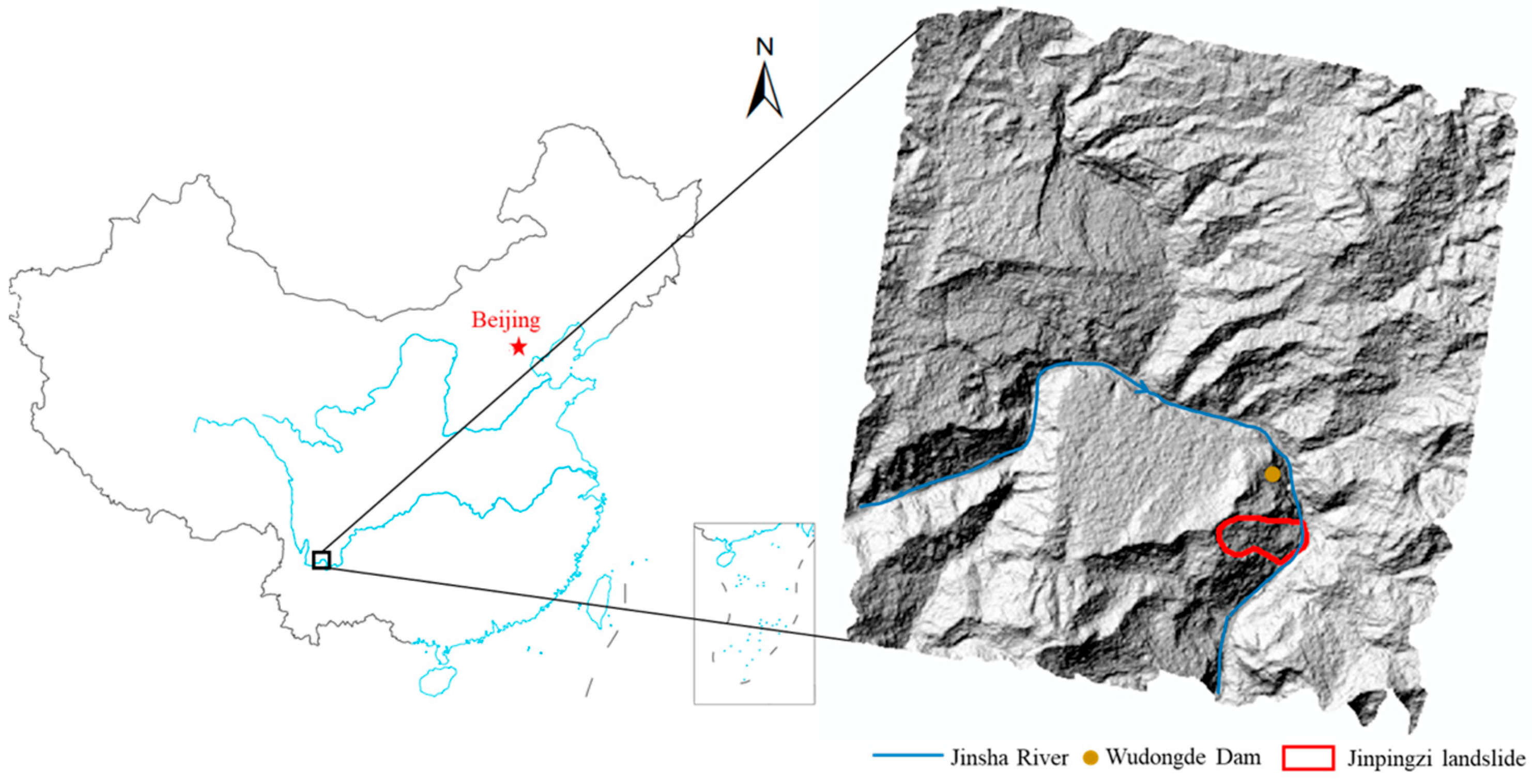
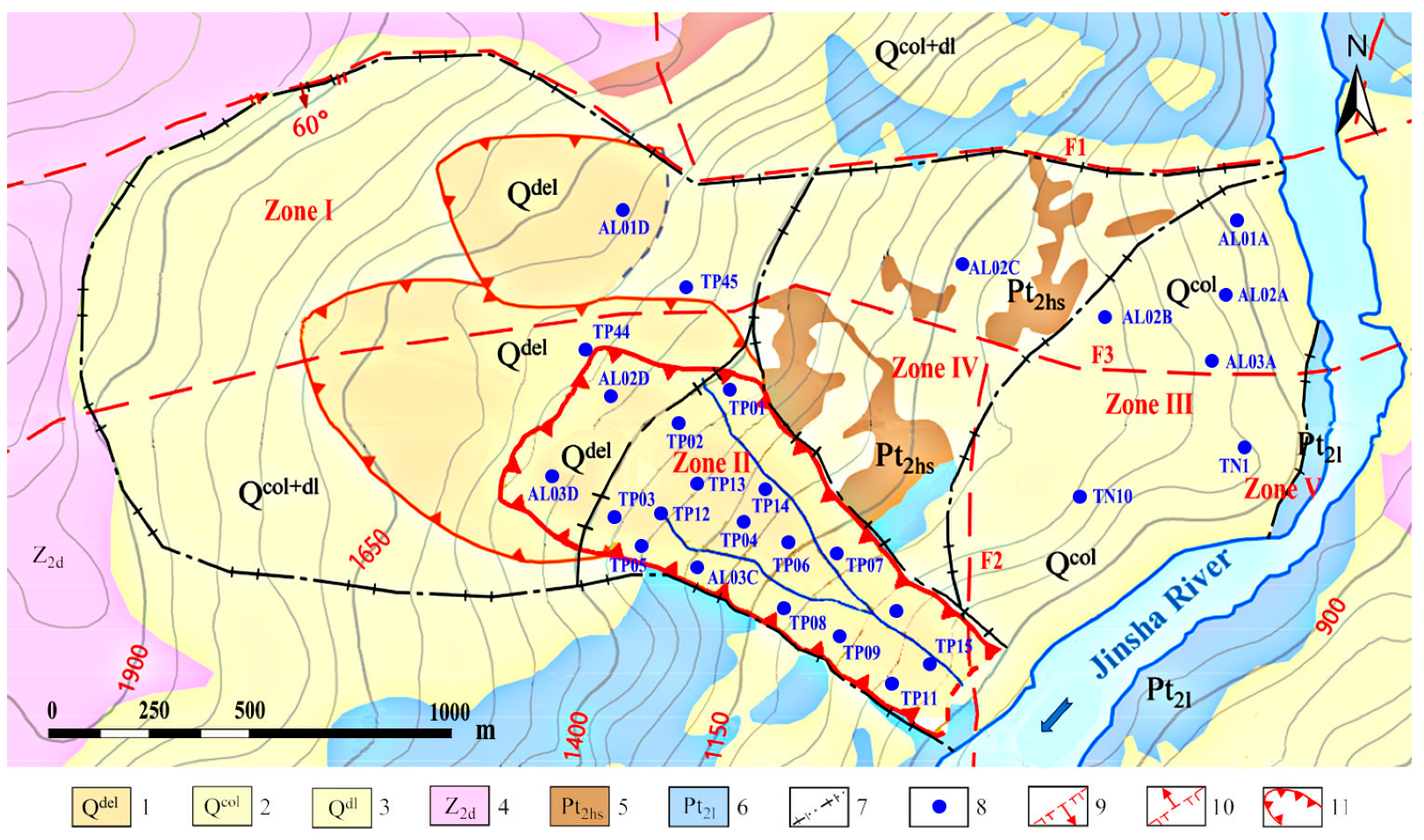
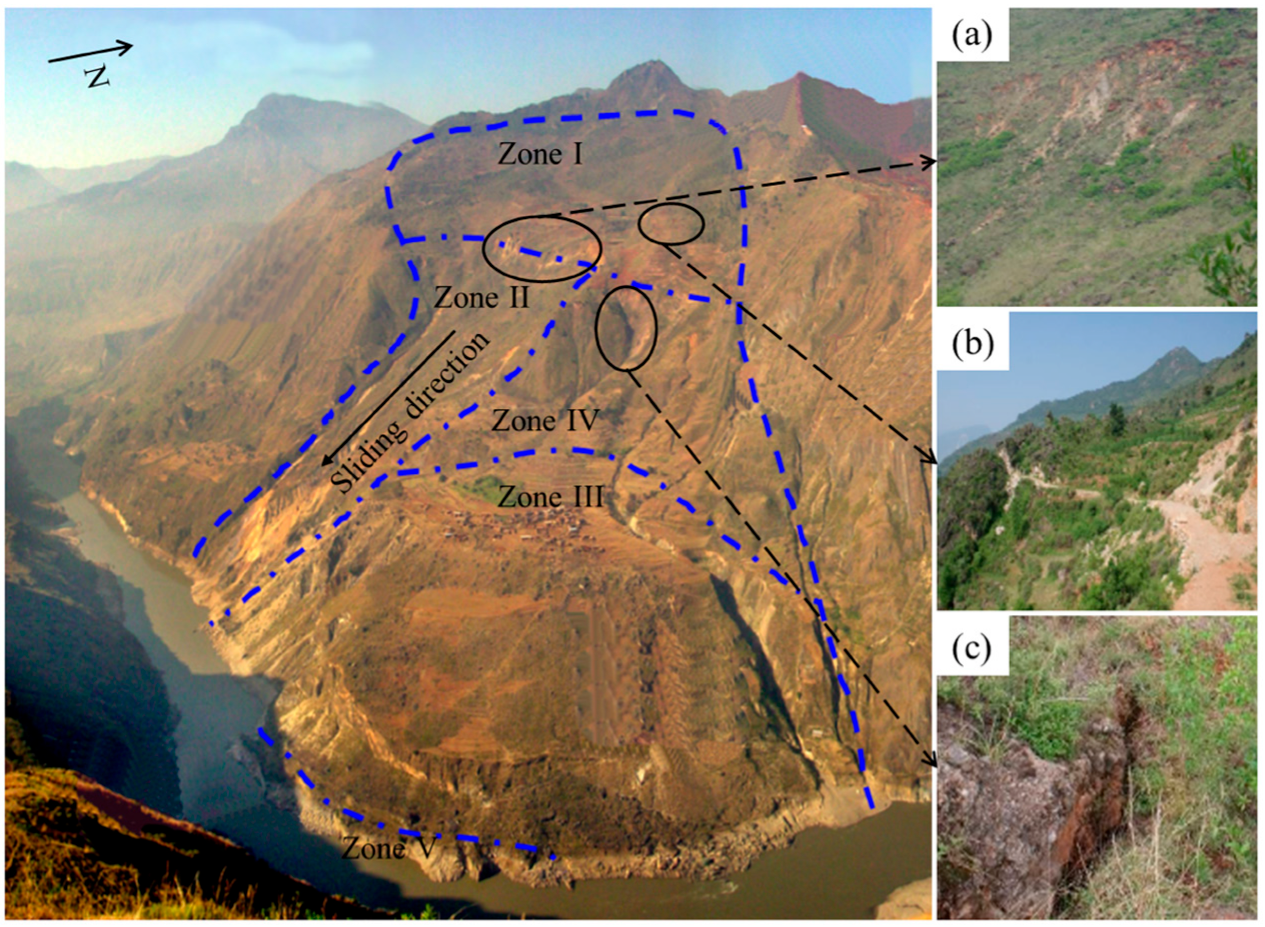
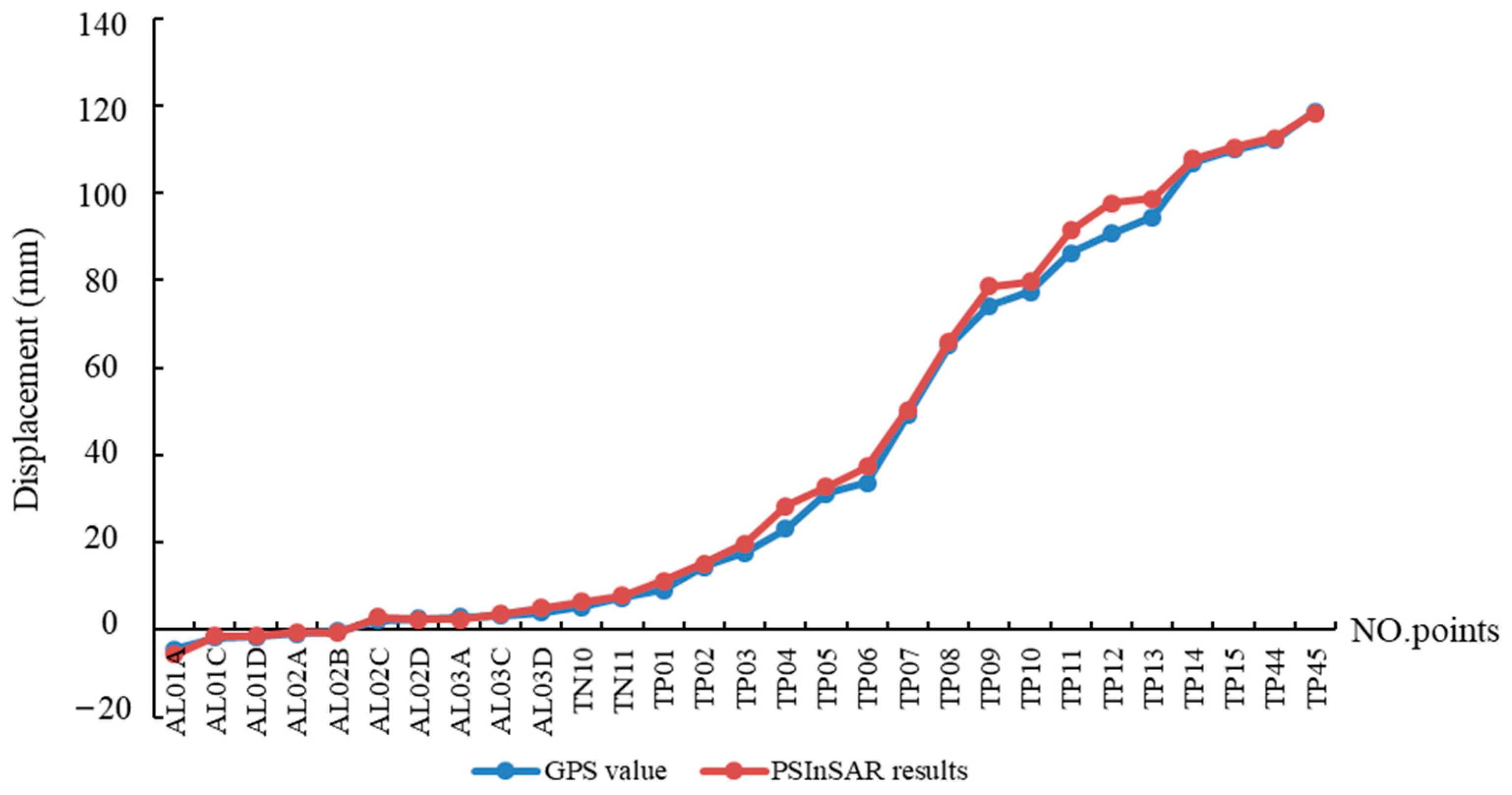

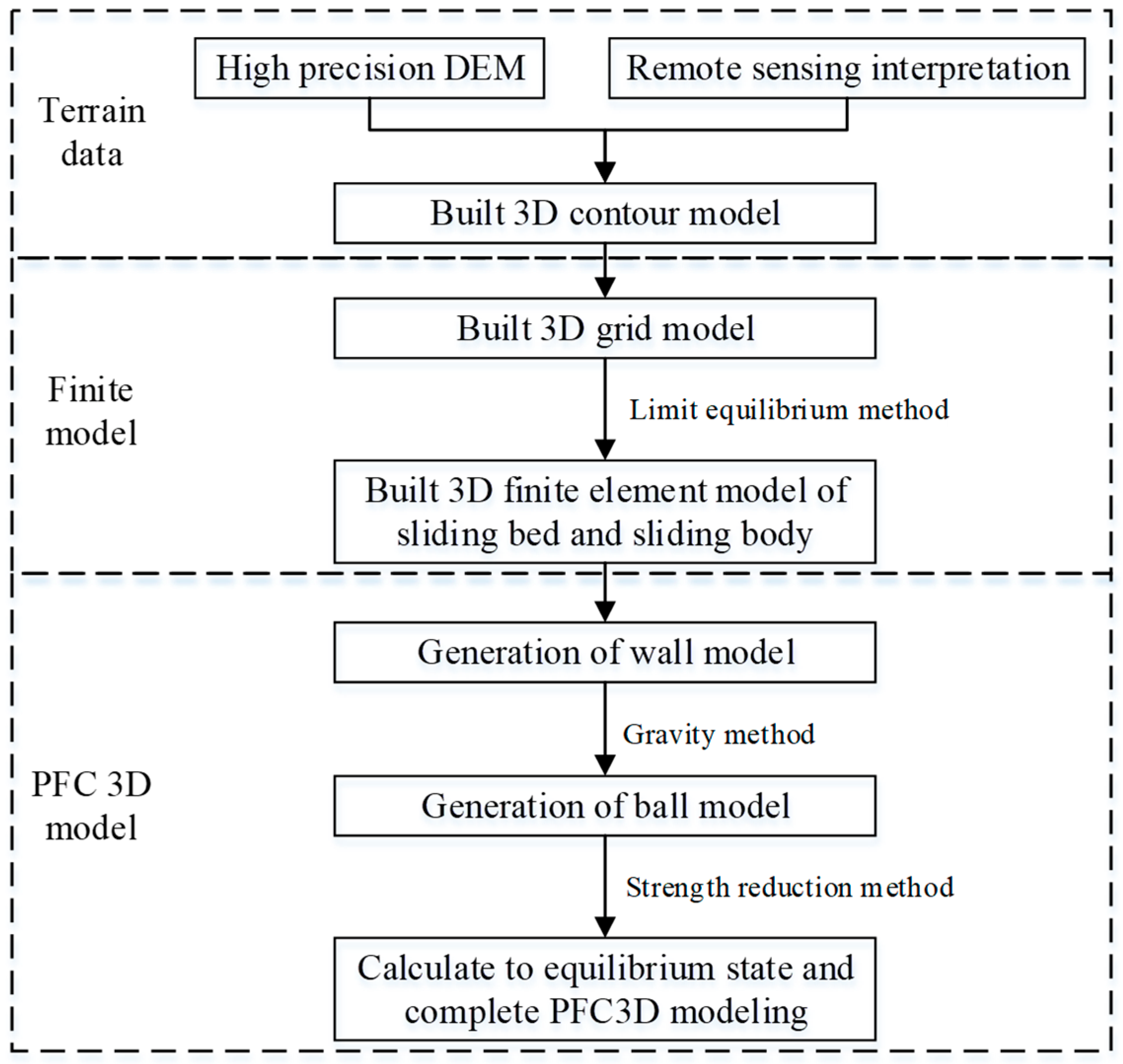
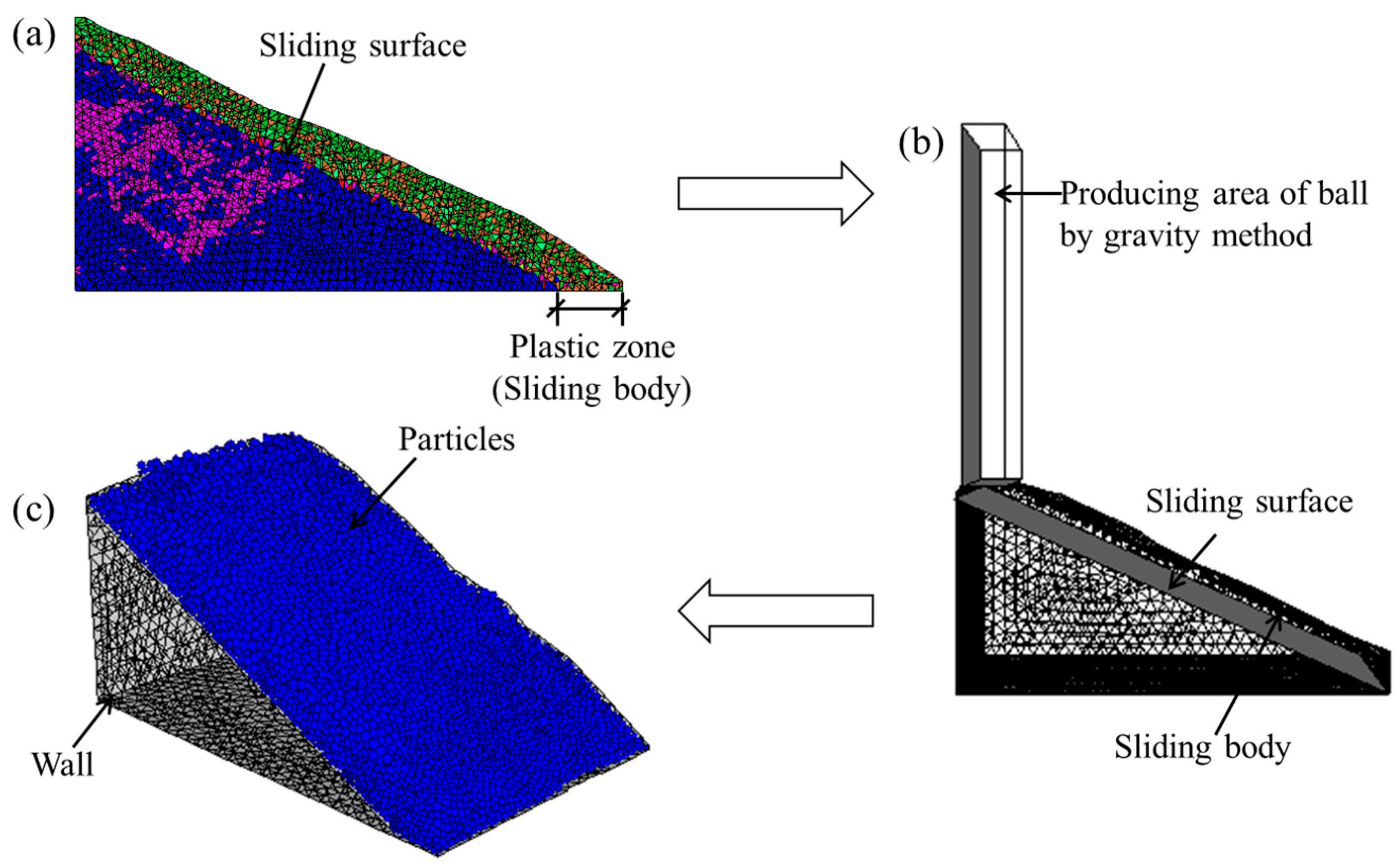


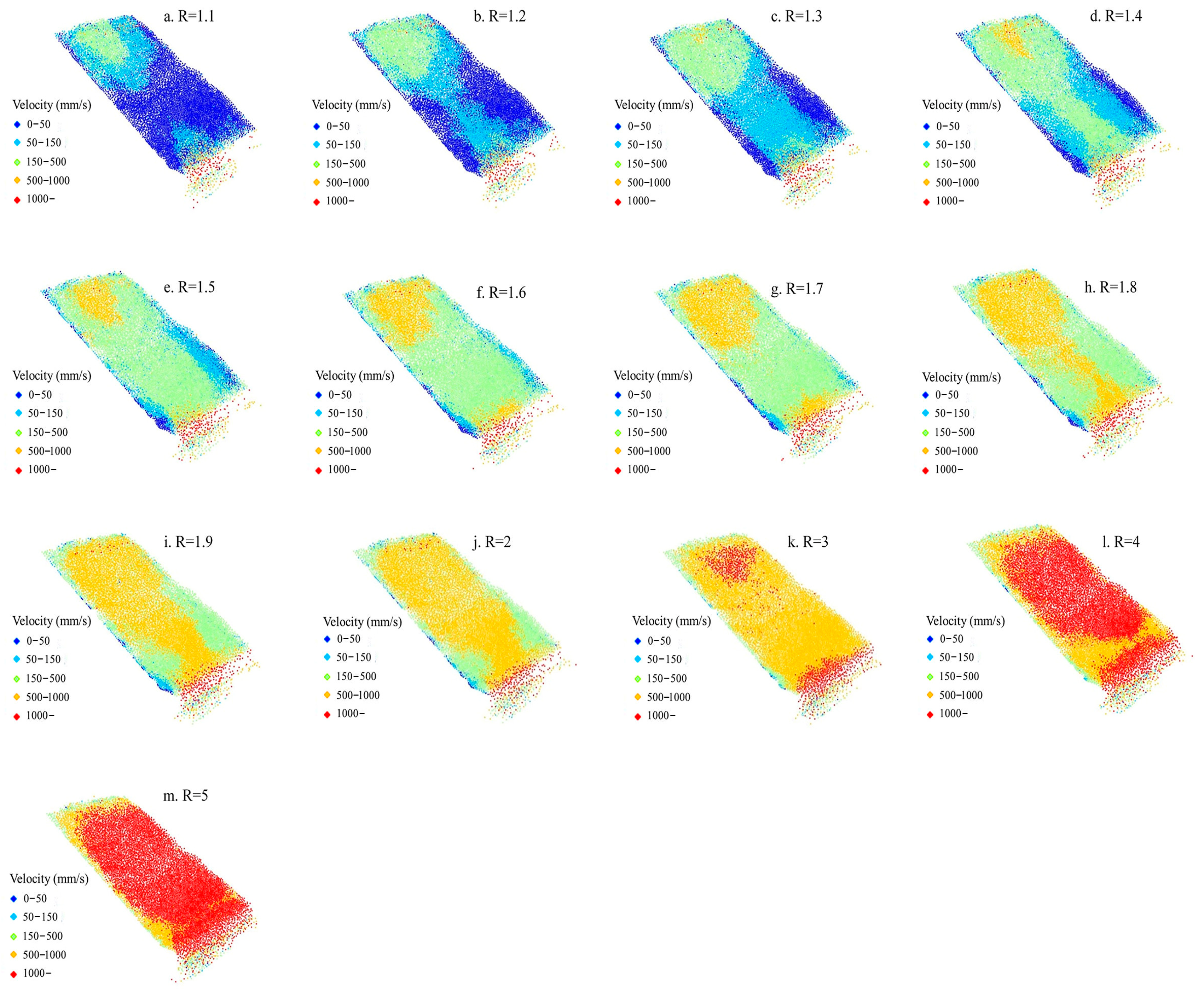

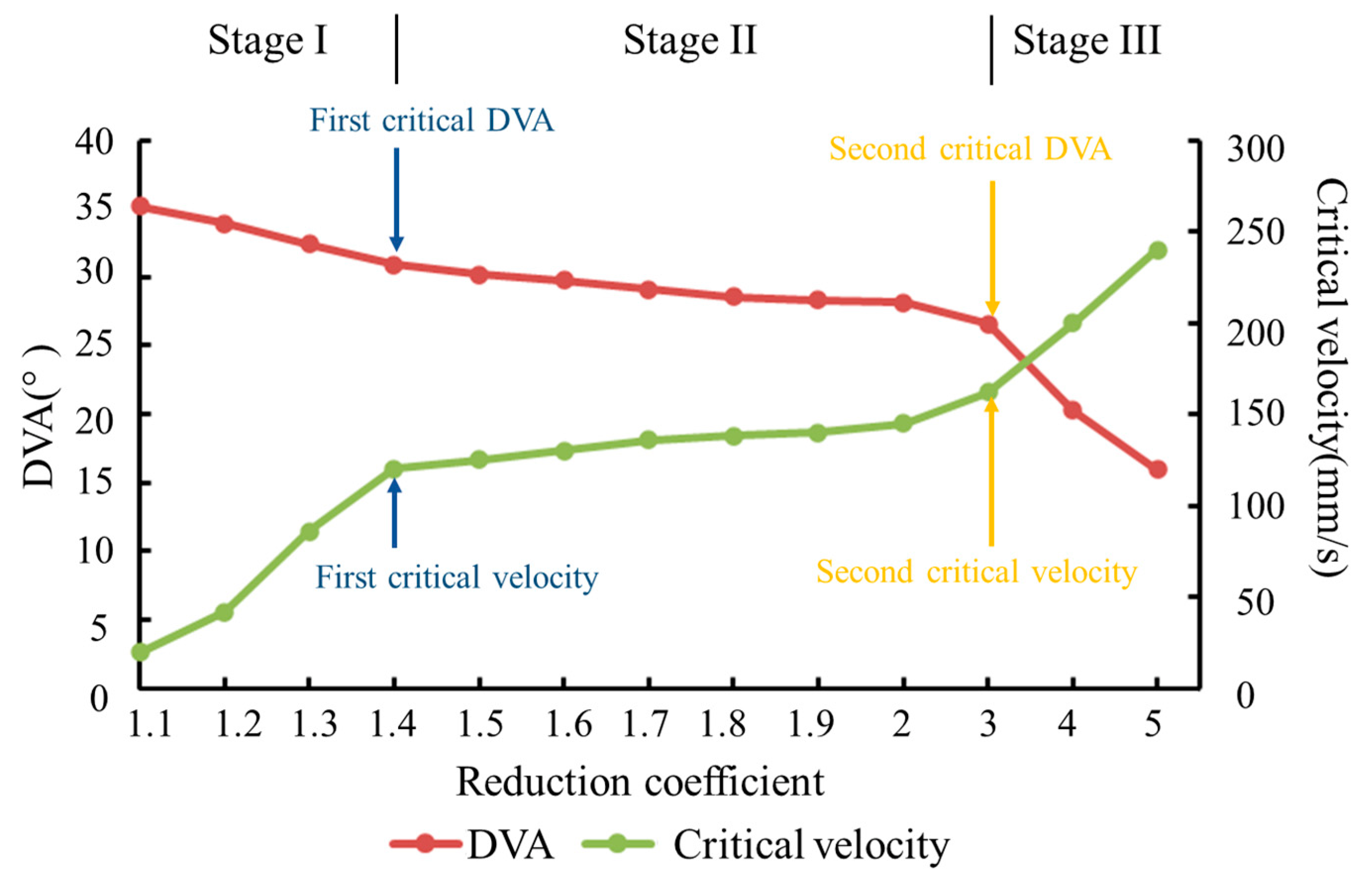
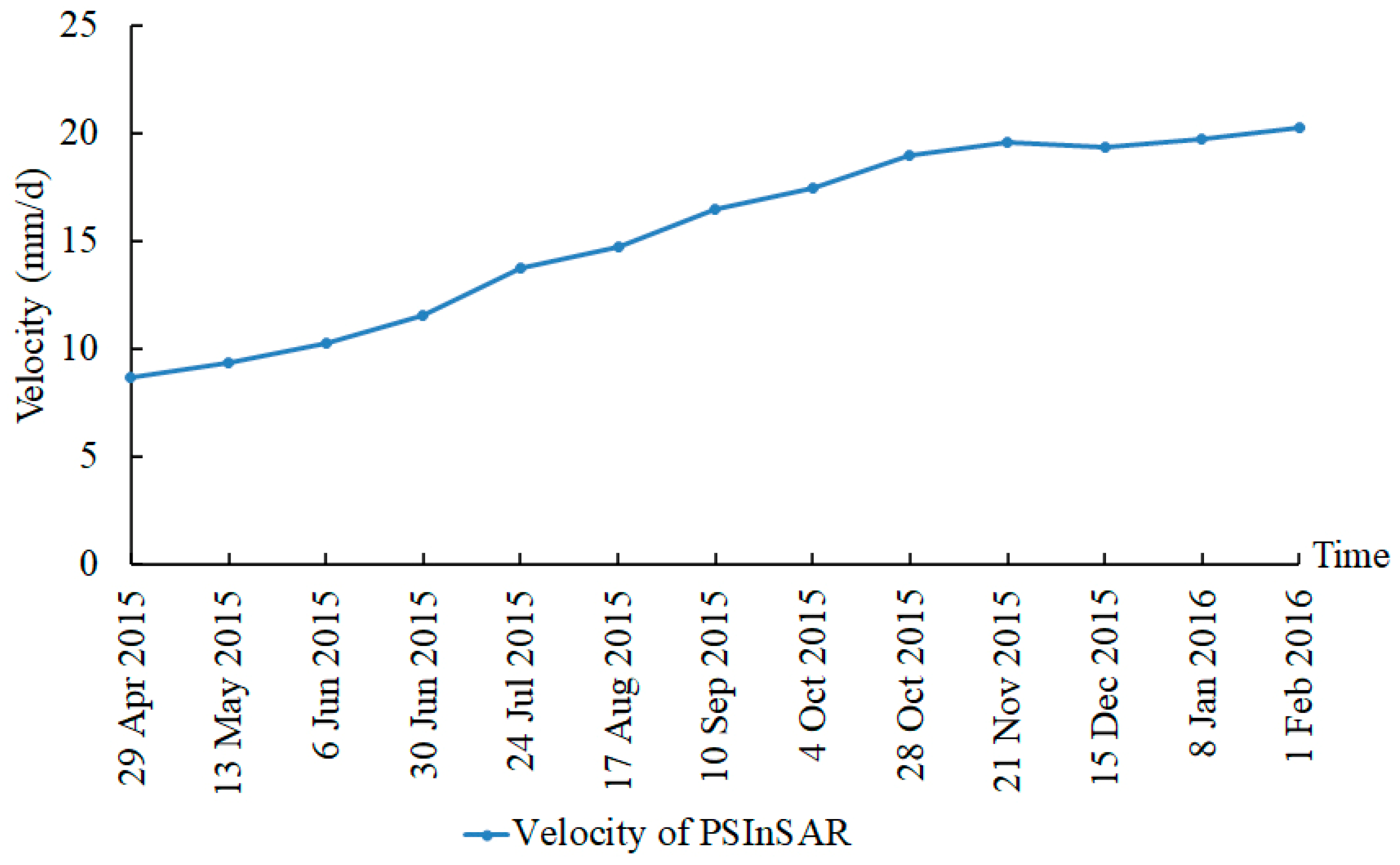
| Parameter | Definition | Value |
|---|---|---|
| Rmin | Minimum particle radius (cm) | 3.75 |
| Rmax | Maximum particle radius (cm) | 6.25 |
| Rmax/Rmin | Particle radius ratio | 1.67 |
| Particle density (kg/m3) | 2150 | |
| Particle normal-to-shear stiffness ratio | 0.33 | |
| Parallel-bond normal-to-shear stiffness ratio | 0.33 | |
| Particle contact modulus (GPa) | 27.5 | |
| Bond effective modulus (GPa) | 27.5 | |
| Micro-friction coefficient | 0.75 | |
| Bond normal strength (MPa) | 9.8 | |
| Bond tangential strength (MPa) | 29.7 |
Disclaimer/Publisher’s Note: The statements, opinions and data contained in all publications are solely those of the individual author(s) and contributor(s) and not of MDPI and/or the editor(s). MDPI and/or the editor(s) disclaim responsibility for any injury to people or property resulting from any ideas, methods, instructions or products referred to in the content. |
© 2023 by the authors. Licensee MDPI, Basel, Switzerland. This article is an open access article distributed under the terms and conditions of the Creative Commons Attribution (CC BY) license (https://creativecommons.org/licenses/by/4.0/).
Share and Cite
Huang, J.; Du, W.; Xie, M. Numerical Modeling of Kinetic Features and Stability Analysis of Jinpingzi Landslide. Land 2023, 12, 679. https://doi.org/10.3390/land12030679
Huang J, Du W, Xie M. Numerical Modeling of Kinetic Features and Stability Analysis of Jinpingzi Landslide. Land. 2023; 12(3):679. https://doi.org/10.3390/land12030679
Chicago/Turabian StyleHuang, Jiaxuan, Weichao Du, and Mowen Xie. 2023. "Numerical Modeling of Kinetic Features and Stability Analysis of Jinpingzi Landslide" Land 12, no. 3: 679. https://doi.org/10.3390/land12030679
APA StyleHuang, J., Du, W., & Xie, M. (2023). Numerical Modeling of Kinetic Features and Stability Analysis of Jinpingzi Landslide. Land, 12(3), 679. https://doi.org/10.3390/land12030679







